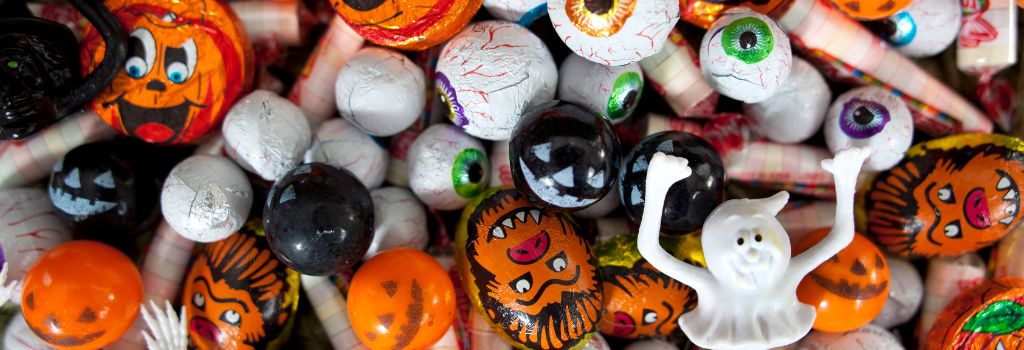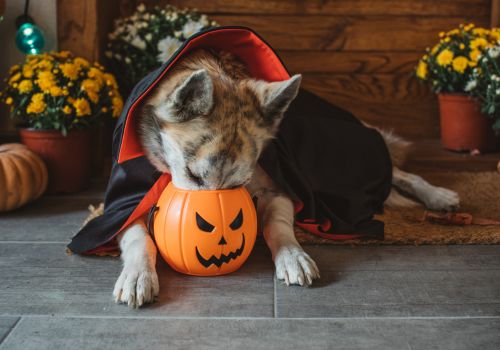According to the Pet Poison Helpline, Halloween week is their busiest. Calls jump by 12%, and hundreds of panicked pet parents call in looking for advice after their dog or cat got into something they shouldn’t have. Cellophane wrappers, lollipop sticks, plastic spider rings, candy, and all the assorted trappings of Halloween can pose a danger to curious pets that end up rifling through a candy pail or picking up treats off the floor.
Even if your pet is usually well-behaved or doesn’t try to eat “people food,” the excitement and chaos of Halloween night can create the perfect recipe for a pet emergency. Think about it; is your puppy always curious and inspecting your grocery bags after you bring them in the house? Does your cat always jump up on the table to get a good look at what you just put down? These normally innocent and unproblematic behaviors can become a real scary situation on Halloween if you plan on having any candy in your house!
From poisoning and upset stomachs to choking and respiratory distress, candy and other Halloween treats can pose a number of dangers to our pets, so it’s imperative for pet owners to know exactly what treats their pets can and can’t indulge in this Halloween season, as well as how to act if they do get hold of something dangerous or toxic. Let’s get started.

Chocolate
The first Halloween treat on our list is probably one of the most obvious, but that doesn’t stop curious cats and dogs from getting hold of it year after year.
Most people know chocolate is dangerous for dogs and cats, but don’t know that even a small amount can leave your pet feeling sick. Chocolate contains both theobromine and caffeine, two ingredients that are toxic to both dogs and cats. Our pets metabolize these two compounds differently – and more slowly – than we do, making the effects of them that much more dangerous.
The toxicity of chocolate will depend on the type of chocolate as well as the weight of the pet that consumed it. While the concentrations of these two ingredients can differ depending on the type of chocolate, they can all affect a pet’s heart, nervous system, and kidneys – and give your pet a nasty stomach ache – regardless of their formulation. Typically, baking chocolate and dark chocolate have the highest concentrations of dangerous ingredients, but other types like milk and white chocolate can still be harmful. So keeping all chocolate away from your pets is the best way to prevent any Halloween emergencies.
In the event that your pet ate chocolate, you can use tools like Merck’s Chocolate Toxicity Calculator to determine your pet’s individual risk based on the type of chocolate and how much was consumed.
Chocolate Raisins
While there are a number of chocolate-based candies that should be kept away from dogs and cats, chocolate-covered raisins are double the trouble. In addition to the toxic components of chocolate, raisins also contain toxins that may cause sudden kidney failure in dogs and cats.
Depending on your pet's weight, even a few chocolate-covered raisins can be incredibly dangerous, leading to toxicity symptoms including vomiting, diarrhea, lethargy, loss of appetite, and decreased urination. Because chocolate-covered raisins combine the dangers of two different toxic foods, all situations involving these treats should be treated as an emergency, and your pet should be evaluated by a veterinarian as soon as possible.
Candy Corn
Unfortunately, seasonal candies like candy corn are very high in sugar and may contain additives and dyes that can wreak havoc on a pet’s digestive system, causing vomiting, diarrhea, and general discomfort. Pancreatitis is also a common concern for pets who consume candy corn, as the high sugar and fat content of this Fall treat can trigger inflammation of an animal's pancreas.
Some brands of candy corn may also contain xylitol, a type of sweetener that is highly toxic to dogs and cats, and can cause a rapid drop in their blood sugar, resulting in seizures and even liver failure. So, while candy corn may be a fun and festive snack for us, it’s a good idea to keep it stored in a secure area where your dog or cat can’t sneak a few bites!
Hard Candy
While the ingredients in many hard candies aren't ideal for our pets to consume, the real danger surrounding these treats is the risk they present for choking. Hard candies can be a major choking hazard for pets of all sizes due to their small size and round or oval shape that can easily slip down a dog or cat's throat.
These candies are true to their name and have a hard and brittle composition, making it difficult for pets to bite through them and break them down. Aside from the risks of choking, swallowing pieces of hard candy whole can lead to obstruction in a dog or cat’s intestines. Depending on the severity of the obstruction, surgery may be required, and in some cases, these obstructions can even be life-threatening and lead to long-term damage to your pet’s digestive system, making cheap hard candies a scary and expensive risk to keep around your pets this Halloween.
Sugar Free Candy
Sugar-free candies have become more and more popular in recent years, as many consumers have become more health-conscious. But while they might be a good alternative for people looking to cut back on their sugar intake, they are incredibly dangerous for our dogs and cats.
Many sugar-free candies, mints, and gums contain xylitol, which is extremely toxic to dogs. As we discussed, xylitol causes a rapid, life-threatening drop in blood sugar and can potentially lead to liver damage under the right conditions. Pet owners should take extra care when bringing anything sweetened with xylitol into their home, which can extend beyond traditional candies into other foods like peanut butter, baked goods, and gums or mints.
Gummies and Caramel
Don’t let the fun shapes and flavors fool you; these chewy candies are absolutely no fun for pets to get hold of. These sticky treats can cause choking or intestinal blockage if swallowed, and their high sugar content can lead to stomach upset and pancreatitis, especially in dogs.
Some gummies are also coated with sour powders or contain xylitol, adding even more risk for toxicity.
It’s Not Just Candy That Can Be Dangerous for Pets on Halloween

It’s not just candy that can pose a problem. Small toys, spider rings, candy wrappers, and glow sticks can also be a hazard if your pet gets hold of them. So be sure to keep those pumpkin pails and candy bowls for the trick-or-treaters in a safe place that your pet can’t get into.
Don’t forget about your trash cans either! As you know, dogs are not above exploring your garbage cans, so if you don’t have lids on your trash cans, then you may want to make a specific designated trash area for candy-related trash. A plastic bag kept in a high cupboard or pantry shelf could work.
As you know, it only takes a second for a curious pet to get into something they shouldn’t. Prepare your family, supervise the goodies, and keep the people treats away from your dogs and cats.
Symptoms of Candy Poisoning in Dogs and Cats
Yes, those innocent-looking candies represent far more than calories when it comes to your pet’s health. They can poison your dog or cat.
If you suspect your pet got into the candy dish, or you know it for a fact, here are some common symptoms of poisoning to be on the lookout for:
- Vomiting
- Diarrhea
- Unusual behavior like extreme lethargy or agitation
- Seizures
It’s important to know that such symptoms can happen within minutes of ingesting Halloween candy, or it can take a couple of days for the symptoms to present themselves. Because of this unpredictability, it’s best to try to avoid candy ingestion in the first place.
What to Do If Your Cat or Dog Ate Candy
If you do have an emergency, the Pet Poison Helpline number is 800-213-6680. If you must call a pet poison hotline, it's helpful to be ready with:
- Your credit card (there is generally a fee)
- Your pet's age and approximate weight
- Ingredients and the amount of the item ingested
- A notepad to write down instructions and your case number
If your pet got into a lot of more toxic candy like chocolate or sugar-free candies, you should bring them to the vet immediately to be evaluated.
If you have questions and you'd like to reach out to us, you can call us directly at (513) 563-0410, or you can email us at info@ebapethospital.com. Don't forget to follow us on social media Facebook, Instagram.

